SVENSK STANDARD
SS-ISO 15031-6:2015
Fastställd/Approved: 2015-09-09
Publicerad/Published: 2015-09-16
Utgåva/Edition: 3
Språk/Language: engelska/English
ICS: 13.040.50; 43.040.10
Vägfordon – Kommunikation mellan fordon och extern
utrustning för emissionsrelaterad diagnostik –
Del 6: Definitioner av felkoder (ISO 15031-6:2015, IDT)
Road vehicles – Communication between vehicle and external
equipment for emissions-related diagnostics –
Part 6: Diagnostic trouble code definitions
(ISO 15031-6:2015, IDT)
�
Standarder får världen att fungera
SIS (Swedish Standards Institute) är en fristående ideell förening med medlemmar från både privat och offentlig
sektor. Vi är en del av det europeiska och globala nätverk som utarbetar internationella standarder. Standarder är
dokumenterad kunskap utvecklad av framstående aktörer inom industri, näringsliv och samhälle och befrämjar
handel över gränser, bidrar till att processer och produkter blir säkrare samt effektiviserar din verksamhet.
Delta och påverka
Som medlem i SIS har du möjlighet att påverka framtida standarder inom ditt område
på nationell, europeisk och global nivå. Du får samtidigt tillgång till tidig information om
utvecklingen inom din bransch.
Ta del av det färdiga arbetet
Vi erbjuder våra kunder allt som rör standarder och deras tillämpning. Hos oss kan du köpa
alla publikationer du behöver – allt från enskilda standarder, tekniska rapporter och standard-
paket till handböcker och onlinetjänster. Genom vår webbtjänst e-nav får du tillgång till
ett lättnavigerat bibliotek där alla standarder som är aktuella för ditt företag finns tillgängliga.
Standarder och handböcker är källor till kunskap. Vi säljer dem.
Utveckla din kompetens och lyckas bättre i ditt arbete
Hos SIS kan du gå öppna eller företagsinterna utbildningar kring innehåll och tillämpning
av standarder. Genom vår närhet till den internationella utvecklingen och ISO får du rätt
kunskap i rätt tid, direkt från källan. Med vår kunskap om standarders möjligheter hjälper
vi våra kunder att skapa verklig nytta och lönsamhet i sina verksamheter.
Vill du veta mer om SIS eller hur standarder kan effektivisera din verksamhet är
du välkommen in på www.sis.se eller ta kontakt med oss på tel 08-555 523 00.
Standards make the world go round
SIS (Swedish Standards Institute) is an independent non-profit organisation with members from both the private
and public sectors. We are part of the European and global network that draws up international standards. Standards
consist of documented knowledge developed by prominent actors within the industry, business world and society.
They promote cross-border trade, they help to make processes and products safer and they streamline your
organisation.
Take part and have influence
As a member of SIS you will have the possibility to participate in standardization activities
on national, European and global level. The membership in SIS will give you the opportunity
to influence future standards and gain access to early stage information about developments
within your field.
Get to know the finished work
We offer our customers everything in connection with standards and their application. You
can purchase all the publications you need from us - everything from individual standards,
technical reports and standard packages through to manuals and online services. Our web
service e-nav gives you access to an easy-to-navigate library where all standards that are
relevant to your company are available. Standards and manuals are sources of knowledge.
We sell them.
Increase understanding and improve perception
With SIS you can undergo either shared or in-house training in the content and application
of standards. Thanks to our proximity to international development and ISO you receive
the right knowledge at the right time, direct from the source. With our knowledge about the
potential of standards, we assist our customers in creating tangible benefit and profitability
in their organisations.
If you want to know more about SIS, or how standards can streamline your
organisation, please visit www.sis.se or contact us on phone +46 (0)8-555 523 00
�
Den internationella standarden ISO 15031-6:2015 gäller som svensk standard. Detta dokument innehåller
den officiella engelska versionen av ISO 15031-6:2015.
Denna standard ersätter SS-ISO 15031-6:2010, utgåva 2.
The International Standard ISO 15031-6:2015 has the status of a Swedish Standard. This document
contains the official English version of ISO 15031-6:2015.
This standard supersedes the Swedish Standard SS-ISO 15031-6:2010, edition 2.
© Copyright / Upphovsrätten till denna produkt tillhör SIS, Swedish Standards Institute, Stockholm, Sverige.
Användningen av denna produkt regleras av slutanvändarlicensen som återfinns i denna produkt, se standardens sista
sidor.
© Copyright SIS, Swedish Standards Institute, Stockholm, Sweden. All rights reserved. The use of this product is
governed by the end-user licence for this product. You will find the licence in the end of this document.
Upplysningar om sakinnehållet i standarden lämnas av SIS, Swedish Standards Institute, telefon 08-555 520 00.
Standarder kan beställas hos SIS Förlag AB som även lämnar allmänna upplysningar om svensk och utländsk standard.
Information about the content of the standard is available from the Swedish Standards Institute (SIS),
telephone +46 8 555 520 00. Standards may be ordered from SIS Förlag AB, who can also provide general
information about Swedish and foreign standards.
Denna standard är framtagen av kommittén för Datakommunikation och diagnostik för vägfordon, SIS / TK 240 / AG
1.
Har du synpunkter på innehållet i den här standarden, vill du delta i ett kommande revideringsarbete eller
vara med och ta fram andra standarder inom området? Gå in på www.sis.se - där hittar du mer information.
�
�
1
2
3
4
5
6
8
Contents
Page
Foreword ........................................................................................................................................................................................................................................iv
Introduction ..................................................................................................................................................................................................................................v
Scope .................................................................................................................................................................................................................................1
Normative references ......................................................................................................................................................................................1
Terms, definitions, symbols, and abbreviated terms .....................................................................................................2
Terms and definitions .......................................................................................................................................................................2
3.1
Abbreviated terms ...............................................................................................................................................................................2
3.2
Conventions ...............................................................................................................................................................................................................2
Document overview...........................................................................................................................................................................................2
General specification .......................................................................................................................................................................................4
6.1
General code information ..............................................................................................................................................................4
6.2
Sensor location definition .............................................................................................................................................................4
6.2.1
General......................................................................................................................................................................................4
6.2.2 Definition of V6/V8/V12 cylinder engine with two exhaust banks and
four catalysts .......................................................................................................................................................................5
6.2.3 Definition of V6/V8/V12 cylinder engine with two exhaust banks and
three catalysts ....................................................................................................................................................................5
6.2.4 Definition of L4/L5/L6 cylinder engine with one exhaust bank and
two catalysts ........................................................................................................................................................................6
6.2.5 Definition of L4/L5/L6 cylinder engine with one exhaust bank and one catalyst .6
6.2.6 Definition of turbocharger/supercharger pressure sensor location draw-
thru system ...........................................................................................................................................................................6
Format structure ..................................................................................................................................................................................................7
Description .................................................................................................................................................................................................7
7.1
ISO/SAE controlled codes (core DTCs) ..............................................................................................................................9
7.2
7.3 Manufacturer controlled codes (non-uniform DTCs) ............................................................................................9
Body system groupings .................................................................................................................................................................10
7.4
Chassis system groupings ...........................................................................................................................................................10
7.5
Powertrain system groupings .................................................................................................................................................10
7.6
7.7
Network and vehicle integration groupings ...............................................................................................................10
Diagnostic trouble code descriptions ..........................................................................................................................................11
8.1
Diagnostic trouble code application ..................................................................................................................................11
8.2
Powertrain systems .........................................................................................................................................................................11
8.3
Body systems .........................................................................................................................................................................................12
8.4
Chassis systems ...................................................................................................................................................................................12
8.5
Network and vehicle integration systems ....................................................................................................................12
Annex A (normative) Diagnostic trouble code naming guidelines ....................................................................................13
Bibliography .............................................................................................................................................................................................................................16
7
iii
SS-ISO 15031-6:2015 (E)�
Foreword
ISO (the International Organization for Standardization) is a worldwide federation of national standards
bodies (ISO member bodies). The work of preparing International Standards is normally carried out
through ISO technical committees. Each member body interested in a subject for which a technical
committee has been established has the right to be represented on that committee. International
organizations, governmental and non-governmental, in liaison with ISO, also take part in the work.
ISO collaborates closely with the International Electrotechnical Commission (IEC) on all matters of
electrotechnical standardization.
The procedures used to develop this document and those intended for its further maintenance are
described in the ISO/IEC Directives, Part 1. In particular the different approval criteria needed for the
different types of ISO documents should be noted. This document was drafted in accordance with the
editorial rules of the ISO/IEC Directives, Part 2 (see www.iso.org/directives).
Attention is drawn to the possibility that some of the elements of this document may be the subject of
patent rights. ISO shall not be held responsible for identifying any or all such patent rights. Details of
any patent rights identified during the development of the document will be in the Introduction and/or
on the ISO list of patent declarations received (see www.iso.org/patents).
Any trade name used in this document is information given for the convenience of users and does not
constitute an endorsement.
For an explanation on the meaning of ISO specific terms and expressions related to conformity
assessment, as well as information about ISO’s adherence to the WTO principles in the Technical
Barriers to Trade (TBT) see the following URL: Foreword - Supplementary information
The committee responsible for this document is ISO/TC 22, Road vehicles, Subcommittee SC 31, Data
This third edition cancels and replaces the second edition (ISO 15031-6:2010), which has been
technically revised.
ISO 15031 consists of the following parts, under the general title Road vehicles — Communication
between vehicle and external equipment for emissions-related diagnostics:
— Part 1: General information and use case definition
— Part 2: Guidance on terms, definitions, abbreviations and acronyms
— Part 3: Diagnostic connector and related electrical circuits, specification and use
— Part 4: External test equipment
— Part 5: Emissions-related diagnostic services
— Part 6: Diagnostic trouble code definitions
— Part 7: Data link security
communication.
iv
SS-ISO 15031-6:2015 (E)�
Introduction
Overview
ISO 15031 consists of a number of parts which, taken together, provide a coherent self-consistent set of
specifications to facilitate emissions-related diagnostics. ISO 15031-1 provides an introduction to the
series of International Standards. ISO 15031-2 through ISO 15031-7 are based on SAE recommended
practices. This part of ISO 15031 is based on SAE J2012 (Diagnostic Trouble Code Definitions).
This International Standard includes the communication between the vehicle’s On-Board Diagnostic
(OBD) systems and test equipment implemented across vehicles within the scope of the legislated
emissions-related OBD.
To achieve this, it is based on the Open Systems Interconnection (OSI) Basic Reference Model in
accordance with ISO/IEC 7498 and ISO/IEC 10731, which structures communication systems into seven
layers. When mapped on this model, the services specified by this International Standard are broken
into the following layers in accordance with Table 1.
— Diagnostic services (layer 7), specified in the following:
— ISO 15031-5 (emissions-related OBD);
— ISO 27145-3 (WWH-OBD).
— Presentation layer (layer 6), specified in the following:
— ISO 15031-2, SAE J1930-DA;
— ISO 15031-5, SAE J1979-DA;
— ISO 15031-6, SAE J2012-DA (OBD);
— ISO 27145-2, SAE J2012-DA (WWH-OBD).
— Session layer services (layer 5), specified in the following:
— ISO 14229-2 supports ISO 15765-4 DoCAN and ISO 14230-4 DoK-Line protocols;
— ISO 14229-2 is not applicable to the SAE J1850 and ISO 9141-2 protocols.
— Transport layer services (layer 4), specified in the following:
— ISO 15765-2 Transport protocol and network layer services;
— SAE J1850 defined in ISO 15031-5 Emissions-related diagnostic services;
— ISO 9141-2 defined in ISO 15031-5 Emissions-related diagnostic services;
— ISO 14230-4 defined in ISO 15031-5 Emissions-related diagnostic services.
— Network layer services (layer 3), specified in the following:
— ISO 15765-2 Transport protocol and network layer services;
— SAE J1850 defined in ISO 15031-5 Emissions-related diagnostic services;
— ISO 9141-2 defined in ISO 15031-5 Emissions-related diagnostic services;
— ISO 14230-4 defined in ISO 15031-5 Emissions-related diagnostic services.
— Data link layer (layer 2), specified in the following:
— ISO 15765-4, ISO 11898-1, ISO 11898−2;
v
SS-ISO 15031-6:2015 (E)�
Table 1 — Legislated emissions-related OBD/WWH-OBD diagnostic specifications applicable to
the OSI layers
requirements
communication requirements
— SAE J1850;
— ISO 9141-2;
— ISO 14230-2.
— Physical layer (layer 1), specified in the following:
— ISO 15765-4, ISO 11898-1, ISO 11898−2;
— SAE J1850;
— ISO 9141-2;
— ISO 14230-1.
Application
(layer 7)
Presentation
(layer 6)
Session
(layer 5)
Transport
(layer 4)
Network
(layer 3)
Data link
(layer 2)
Physical
(layer 1)
Not applicable
ISO 15031-5
SAE
ISO
J1850
9141-2
Seven layer
according to
ISO/IEC
7498-1
and
ISO/IEC
10731
Applicability OSI 7 layers
ISO 27145-3
ISO 27145-2
Emissions-related OBD communication
ISO 15031-5
ISO 15031-2, -5, -6
SAE J1930-DA/SAE J1979-DA
SAE J2012-DA (OBD)
ISO
ISO
14230-4
15765-2
ISO
ISO
14230-2
11898-1,
ISO
ISO
11898-2
14230-1
Emissions-related WWH-OBD
SAE J1930-DA/SAE J1979-DA
SAE J2012-DA (WWH-OBD)
ISO 14229-2
ISO
ISO
15765-2
13400-2
ISO
ISO
15765-4
27145-4
ISO
ISO
11898-1,
ISO
13400-3
11898-2
ISO 15031 references several SAE documents which contain all terms, data, and DTC definitions.
See Figure 1 with the following definition of content in this International Standard.
— SAE J1930: the document is concerned with a procedure for naming objects and systems and
with the set of words from which names are built. It references SAE J1930-DA which contains all
standardized naming objects, terms, and abbreviations.
— SAE J1979: the document is concerned with the definition of emissions-related diagnostic services
(diagnostic test modes). It references SAE J1979-DA which contains all standardized data items like
PIDs, test IDs, monitor IDs, and InfoType IDs.
— SAE J2012: the document is concerned with the procedure for defining emissions-related diagnostic
trouble codes. It references SAE J2012-DA which contains all standardized data items like DTCs and
FTBs.
SAE document reference concept
vi
SS-ISO 15031-6:2015 (E)�
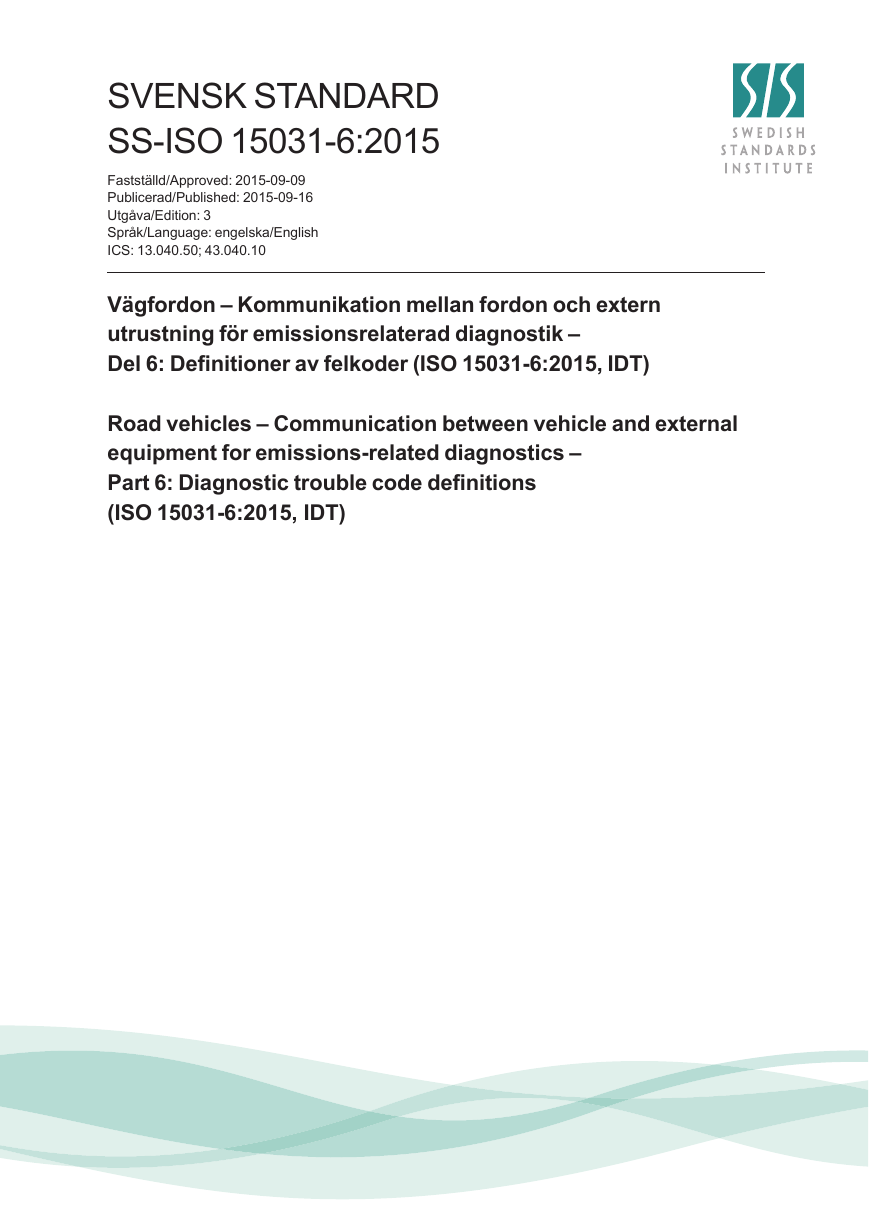
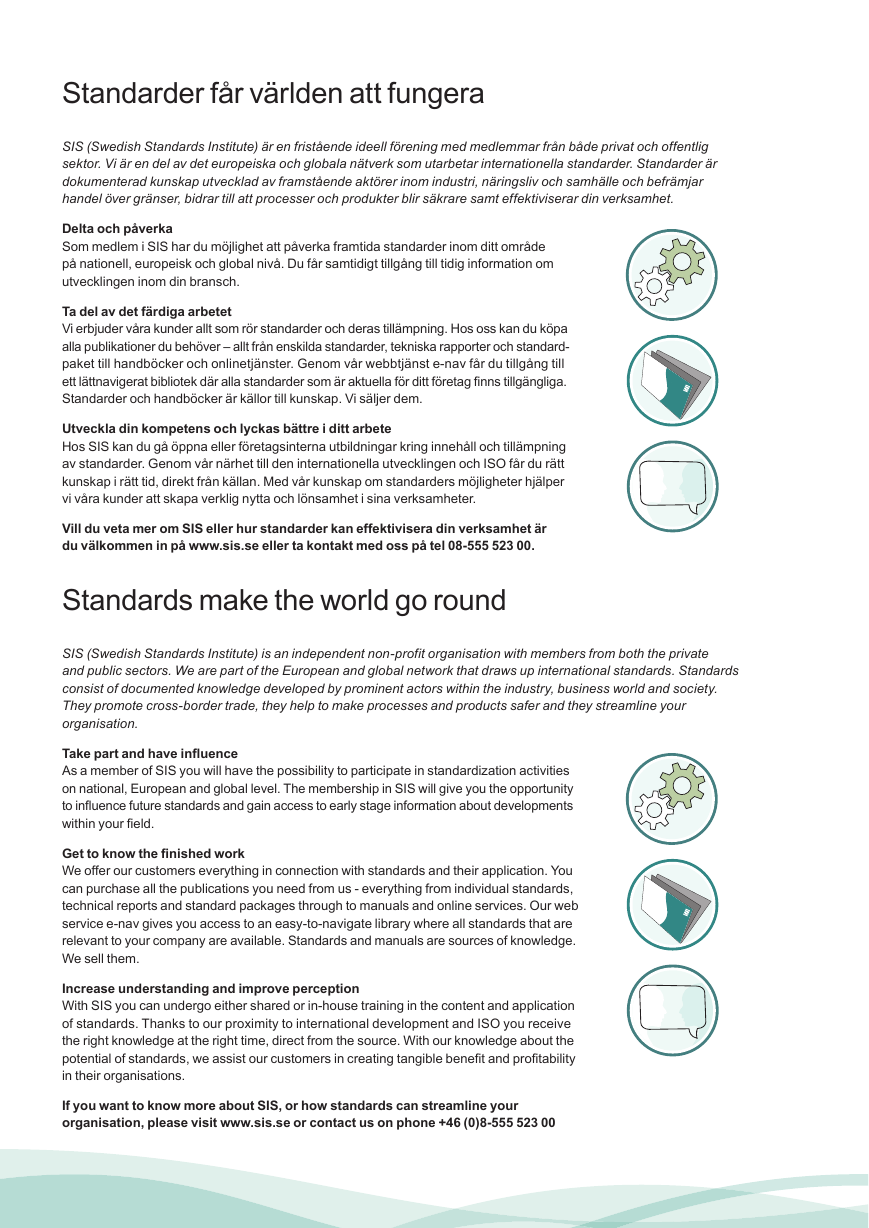
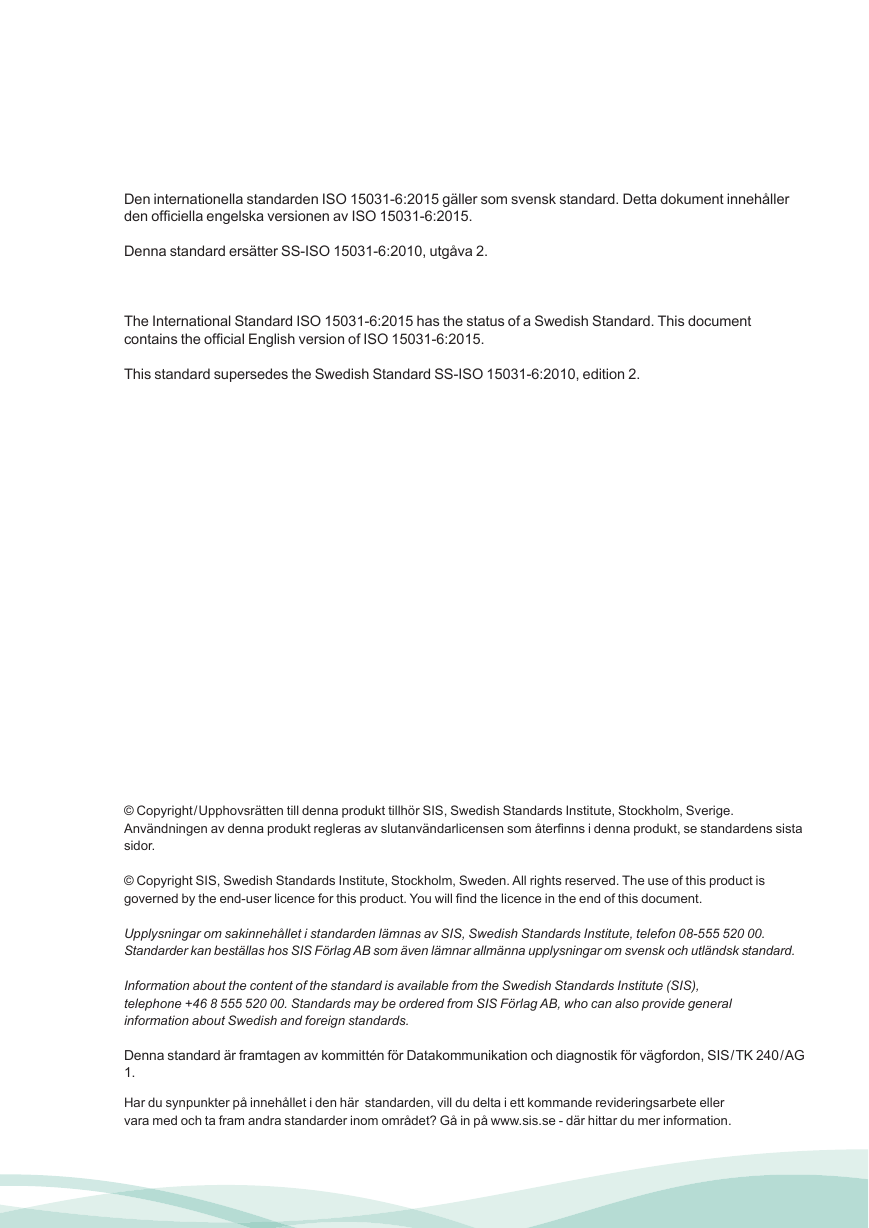

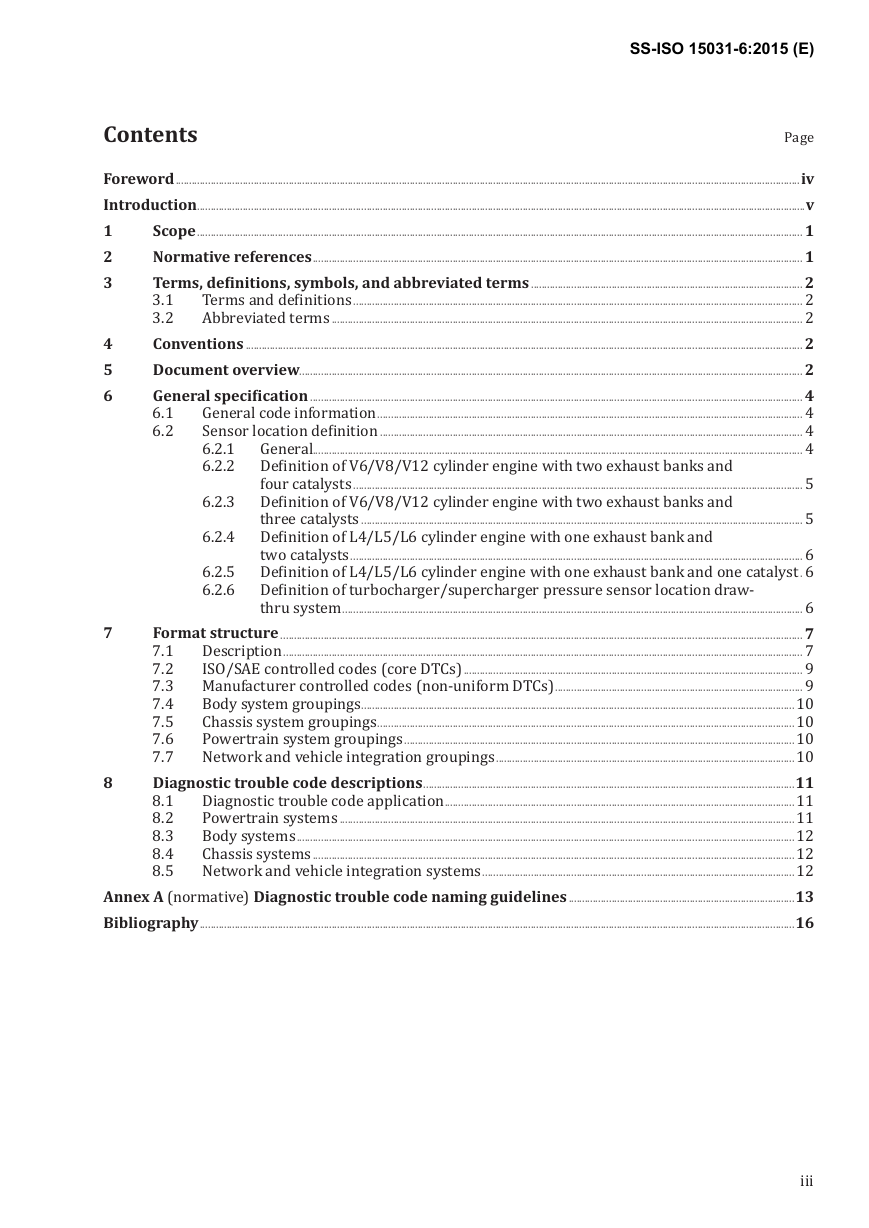
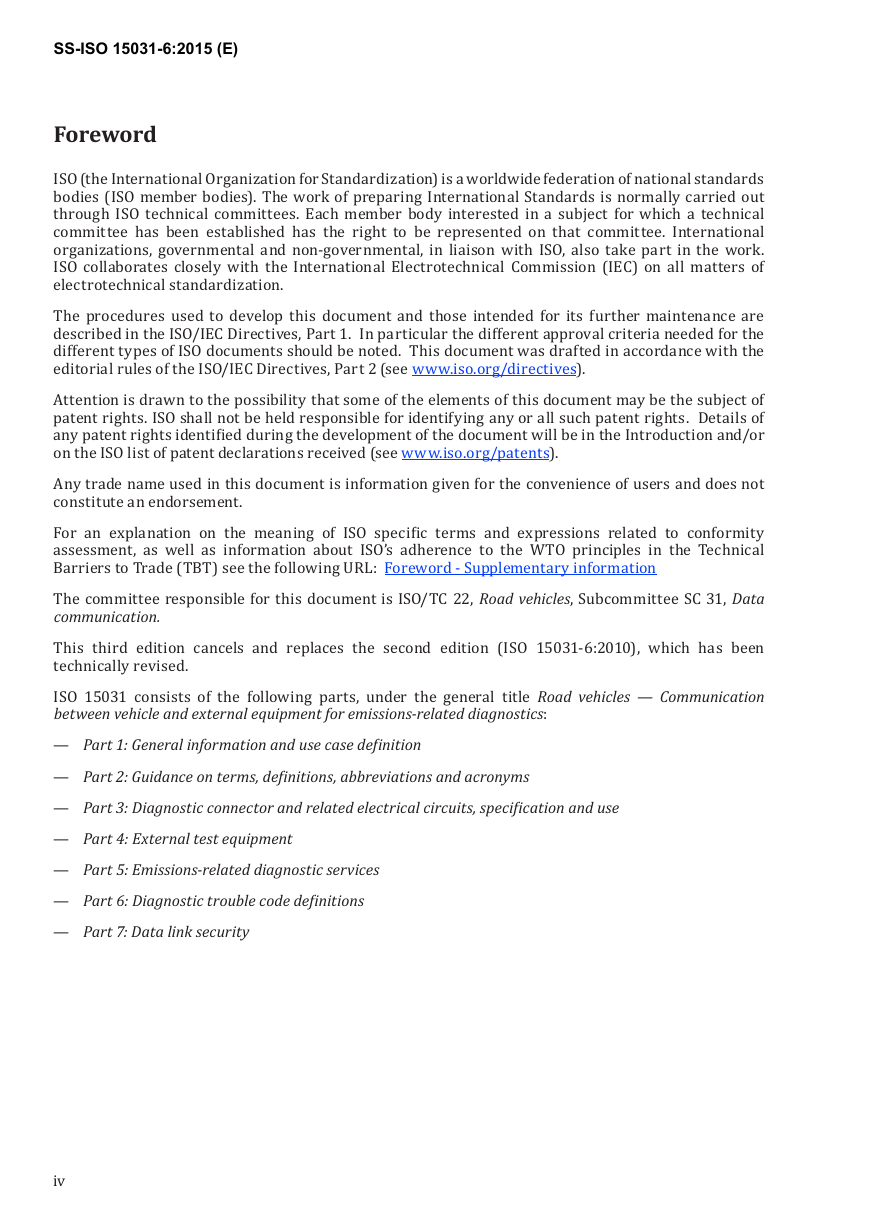
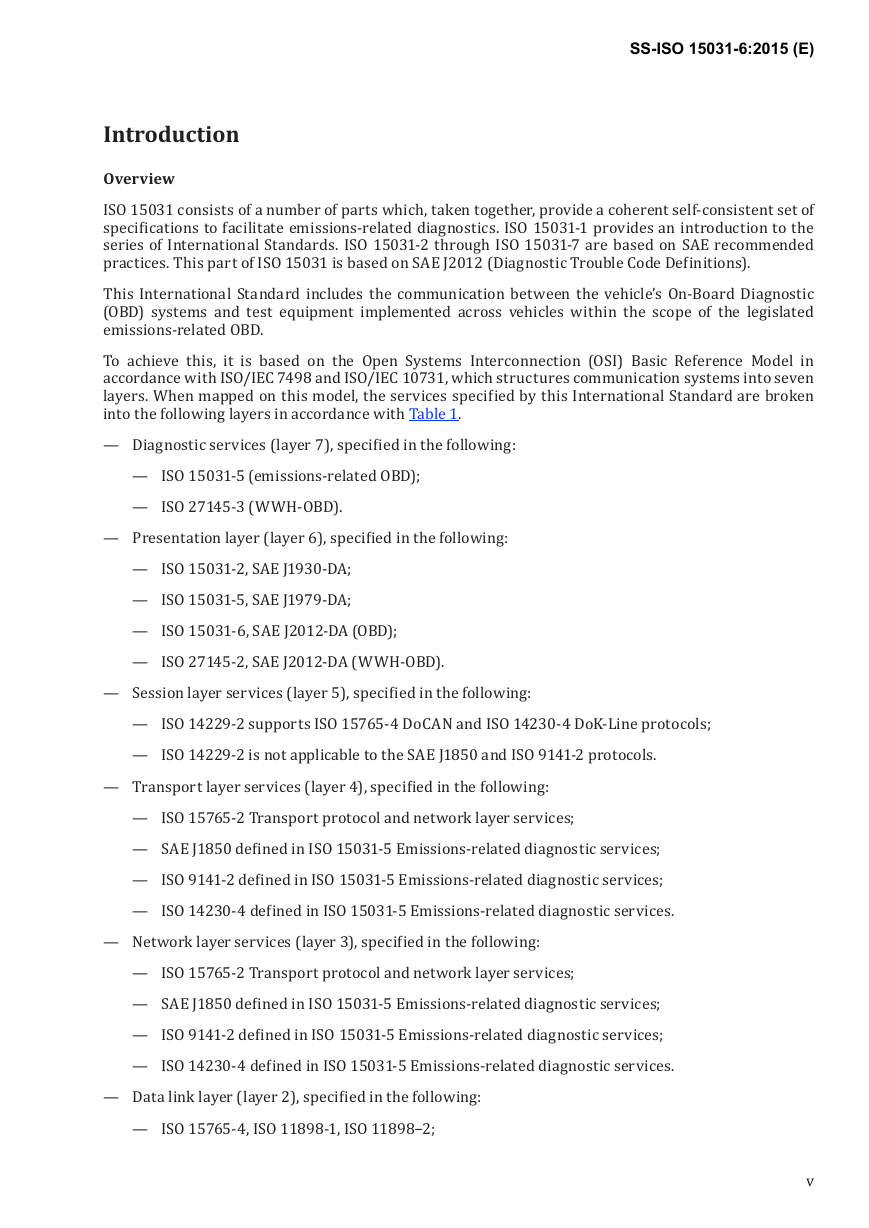
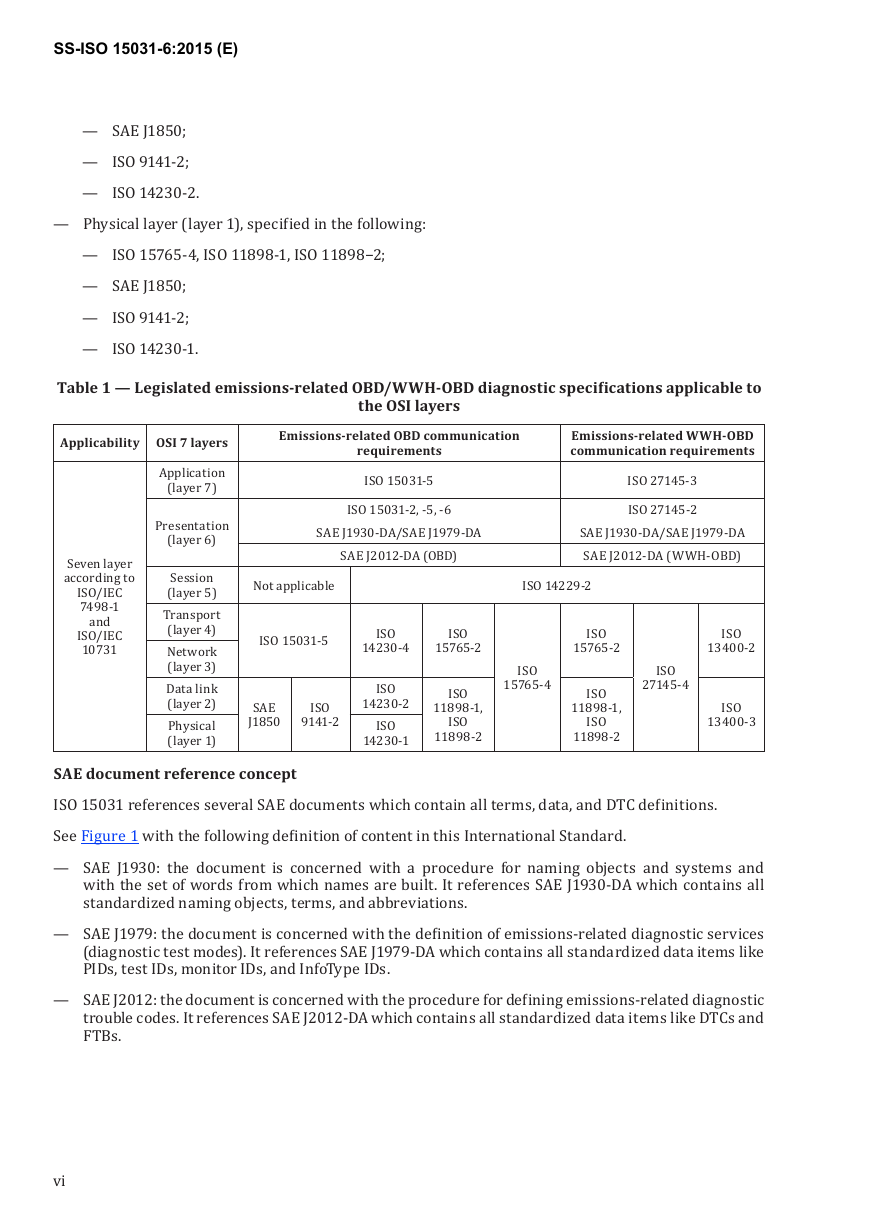








 2023年江西萍乡中考道德与法治真题及答案.doc
2023年江西萍乡中考道德与法治真题及答案.doc 2012年重庆南川中考生物真题及答案.doc
2012年重庆南川中考生物真题及答案.doc 2013年江西师范大学地理学综合及文艺理论基础考研真题.doc
2013年江西师范大学地理学综合及文艺理论基础考研真题.doc 2020年四川甘孜小升初语文真题及答案I卷.doc
2020年四川甘孜小升初语文真题及答案I卷.doc 2020年注册岩土工程师专业基础考试真题及答案.doc
2020年注册岩土工程师专业基础考试真题及答案.doc 2023-2024学年福建省厦门市九年级上学期数学月考试题及答案.doc
2023-2024学年福建省厦门市九年级上学期数学月考试题及答案.doc 2021-2022学年辽宁省沈阳市大东区九年级上学期语文期末试题及答案.doc
2021-2022学年辽宁省沈阳市大东区九年级上学期语文期末试题及答案.doc 2022-2023学年北京东城区初三第一学期物理期末试卷及答案.doc
2022-2023学年北京东城区初三第一学期物理期末试卷及答案.doc 2018上半年江西教师资格初中地理学科知识与教学能力真题及答案.doc
2018上半年江西教师资格初中地理学科知识与教学能力真题及答案.doc 2012年河北国家公务员申论考试真题及答案-省级.doc
2012年河北国家公务员申论考试真题及答案-省级.doc 2020-2021学年江苏省扬州市江都区邵樊片九年级上学期数学第一次质量检测试题及答案.doc
2020-2021学年江苏省扬州市江都区邵樊片九年级上学期数学第一次质量检测试题及答案.doc 2022下半年黑龙江教师资格证中学综合素质真题及答案.doc
2022下半年黑龙江教师资格证中学综合素质真题及答案.doc